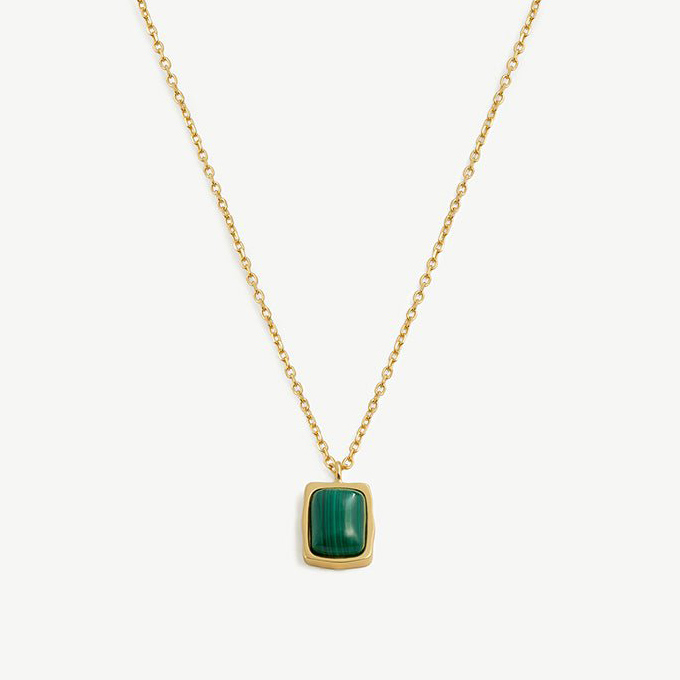Malachite Pendant Silver Necklace: Step-by-Step Manufacturing Process
Introduction
Malachite, with its mesmerizing green swirls, has been a prized gemstone for centuries. When set in sterling silver (925 silver), it creates a stunning pendant necklace that blends natural beauty with timeless elegance.
This 5,000-word guide provides a detailed, step-by-step breakdown of how a malachite pendant silver necklace is manufactured—from raw materials to the finished product. Whether you’re a jewelry designer, retailer, or enthusiast, understanding this process helps in quality control, customization, and supplier negotiations.
1. Sourcing Raw Materials
1.1 Malachite Gemstone Selection
- Origin: Mined primarily in Congo, Russia, and Australia.
- Quality Grades:
- AAA (Top Grade): Vivid green, bold patterns, minimal cracks.
- AA (Medium Grade): Slightly lighter, some veining.
- A (Commercial Grade): Pale with visible imperfections.
- Forms Used in Jewelry:
- Cabochons (Dome-Shaped) – Most common for pendants.
- Beads – For simpler designs.
- Carved Malachite – Artistic engravings.
1.2 Sterling Silver (925 Silver) Procurement
- Composition: 92.5% pure silver + 7.5% alloy (usually copper).
- Why 925 Silver?
- More durable than pure silver.
- Hypoallergenic and tarnish-resistant.
- Common Forms for Pendants:
- Silver Sheets (for handcrafted settings).
- Pre-Cast Bezels (for mass production).
2. Step-by-Step Manufacturing Process
Step 1: Design & CAD Modeling
- Hand Sketching (Traditional method for artisanal pieces).
- 3D CAD Modeling (For precision in mass production).
- Prototyping (Wax or resin models for approval).
Step 2: Malachite Cutting & Shaping
- Slab Cutting – Raw malachite is sliced into workable pieces.
- Cabochon Shaping – Grinding into smooth, domed forms.
- Polishing – Final buffing for a glossy finish.
Step 3: Silver Pendant Casting
- Lost-Wax Casting (Common Method):
- A wax model is created.
- Invested in a plaster mold.
- Molten silver is poured in.
- The wax burns away, leaving a silver pendant frame.
- Alternative: CNC Machining (For intricate designs).
Step 4: Stone Setting
- Bezel Setting (Most secure for malachite):
- The silver bezel is shaped to fit the cabochon.
- The malachite is placed inside.
- The bezel edges are pressed down to secure the stone.
- Prong Setting (Less common, risk of cracking malachite).
Step 5: Polishing & Finishing
- Tumbling – Smooths rough edges.
- Hand Polishing – Using jeweler’s rouge for shine.
- Oxidation (Optional) – Darkening crevices for an antique look.
Step 6: Chain Attachment & Quality Control
- Chain Types:
- Figaro Chain (Classic, durable).
- Box Chain (Modern, sleek).
- QC Checks:
- Stone security (no wobbling).
- Silver purity verification (hallmark stamping).
- Surface defects inspection.
3. Customization Options
3.1 Engraving & Personalization
- Laser Engraving (Names, dates, symbols).
- Hand-Engraved Details (Artisan touch).
3.2 Gold Vermeil or Rhodium Plating
- Gold Vermeil (2.5+ microns of gold over silver).
- Rhodium Plating (Adds scratch resistance & extra shine).
3.3 Ethical & Sustainable Variations
- Recycled Silver (Eco-friendly option).
- Lab-Grown Malachite (For synthetic gem lovers).
4. Common Challenges & Solutions
4.1 Malachite Fragility
- Issue: Prone to cracking during setting.
- Solution: Use bezel settings, avoid prongs.
4.2 Silver Tarnishing
- Issue: Exposure to moisture & air causes darkening.
- Solution: Anti-tarnish coating or proper storage advice.
4.3 Supply Chain Risks
- Issue: Inconsistent malachite quality.
- Solution: Work with certified gemstone suppliers.
5. Conclusion
The journey from raw malachite and silver to a finished pendant necklace involves:
✔ Precision gemstone cutting
✔ Expert metal casting & setting
✔ Meticulous polishing & QC
Understanding this process helps designers create better pieces and retailers source high-quality jewelry.
